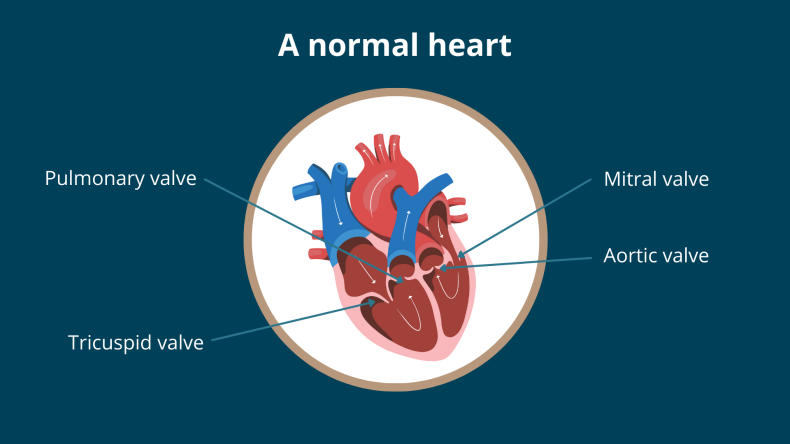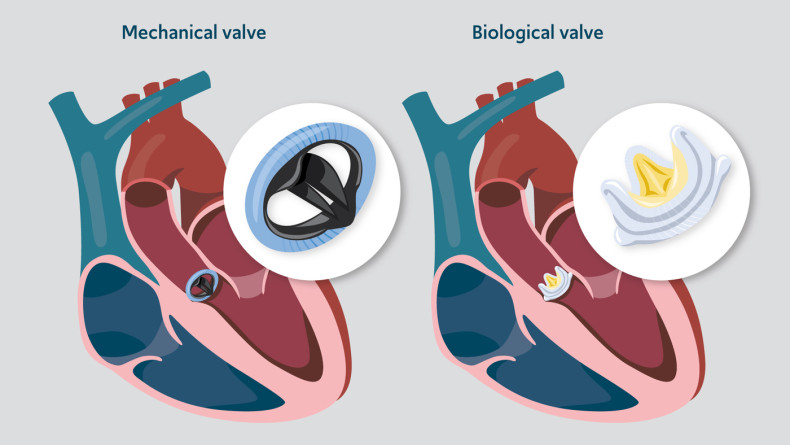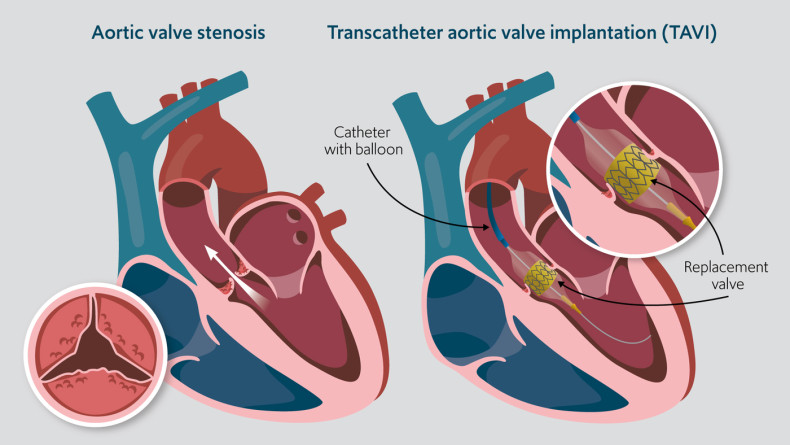Heart valve replacement is surgery to replace a diseased or damaged heart valve with a new prosthetic device. The new heart valve takes over the work of the faulty valve, treating your symptoms and protecting your heart from damage.
Your cardiologist or cardiothoracic surgeon may recommend heart valve replacement if your valve disease is severe, causing symptoms that are affecting your daily life, or if it could cause dangerous complications like abnormal rhythms or heart failure.
The heart’s valves
“The heart has four valves. All the valves work to keep blood flowing properly through the heart. They act as gateways, opening and closing with the heart’s beats to ensure blood flows in one direction and doesn’t leak backwards,” explains our consultant cardiac surgeon, Mr George Asimakopoulos.
The valves are:
- aortic valve: on the left side of the heart between the left ventricle (the lower chamber) and the aorta, the major artery that carries oxygen-rich blood from the heart to the body
- mitral valve: on the left side of the heart between the left atrium (the upper chamber) and the left ventricle (the lower chamber)
- pulmonary valve: on the right side of the heart between the right ventricle and the pulmonary artery which carries blood from the heart to the lungs to collect oxygen
- tricuspid valve: on the right side of the heart between the right atrium and the right ventricle
When a valve is narrowed and can’t open properly, it restricts blood flow. An example is called aortic stenosis, where the aortic valve is affected. If a valve can’t close properly, blood may leak backwards, known as regurgitation or insufficiency.
What is heart valve replacement?
“Heart valve replacement is surgery to replace a faulty heart valve with a new prosthetic device made from synthetic materials or animal tissue. Heart valve replacement can treat valve stenosis and regurgitation” explains Mr Asimakopoulos.
In most types of heart valve replacement, your surgeon will remove the malfunctioning valve and replace it with a new prosthetic valve. However, in transaortic valve implantation or TAVI, your surgeon will insert a new valve inside the existing aortic valve, usually as treatment for aortic stenosis.

A normal heart
Types of valve replacement
Prosthetic valves are made of animal tissue or synthetic material. Your surgeon will recommend one, bearing in mind your age and whether you’re happy to take blood-thinning medications.
- Mechanical valves: These long-lasting valves are made from synthetic materials. They typically last more than twenty years, so they can be better for younger people. They are linked to thrombosis, so you need to take blood-thinning medication for life if you have a mechanical valve.
- Biological or bioprosthetic valves: These are made of animal tissue, usually from a pig or cow. They wear out more quickly than mechanical valves but have a reduced risk of clots, so long-term blood-thinning medications aren’t usually necessary

Prosthetic valves are made of animal tissue or synthetic material
Surgical valve replacement
Surgical valve replacement is an open-heart operation to remove a damaged or diseased valve and stitch a new mechanical or bioprosthetic valve in place.
While both mechanical and most biological valves are sewn into the heart, there are also biological valve that are sutureless. Their implantation is fast and makes minimally invasive surgery easier and safer.
Your cardiothoracic surgeon operates with general anaesthetic (you will be asleep). It is a major surgery involving a long incision along your breastbone, and a heart-lung bypass machine will take over the work of your heart and lungs.
Surgical valve replacement is considered the definitive treatment for most valvular diseases. The surgeon can implant the type of valve that meets your needs, and surgery improves life expectancy and quality of life. However, there are risks with major surgery.
As well as the usual surgical complications of infection and bleeding, valve replacement is linked with:
- thrombosis
- stroke
- heart arrhythmias
- kidney problems
Sadly, some people will die following valve replacement surgery. Studies show that around 2% of people have fatal complications after aortic valve replacement. That figure sounds worrying, but it’s important to remember that this is lower than the risks of not treating severe valve disease.
The chance of suffering a major adverse complication or death can be calculated before the operation by using a mathematical system called EuroSCORE. The younger and the healthier the patient, the lower is the chance of having major complications.
Minimally invasive or keyhole valve replacement surgery
Keyhole surgery is most frequently performed to replace the mitral and tricuspid valves. Your cardiothoracic surgeon operates with general anaesthetic, and a heart-lung bypass machine takes over the work of your heart and lungs.
The surgeon makes several small cuts in your chest wall, including one larger 5cm incision. They insert a tiny camera through the larger incision. This relays images to a monitor. The surgeon replaces the valve using fine instruments inserted through the other incisions.
“Minimally invasive surgery typically results in less post-operative pain, shorter hospital stays, quicker recoveries, fewer complications and a better cosmetic result than traditional open surgery. However, it is not suitable for everyone, and in around one in 50 people, the surgeon may have to convert to an open operation,” explains Mr Asimakopoulos.
Transcatheter aortic valve implantation (TAVI)
TAVI is a minimally invasive procedure to replace the aortic valve and treat aortic valve stenosis. TAVI is carried out by a cardiologists after discussion with a team consisting of cardiologists, cardiac surgeons, radiologists and other specialists. TAVI may be performed under general anaesthetic or sedation.
The surgeon inserts a new valve into your heart without opening the chest. They access the heart using a catheter inserted through a blood vessel in the groin, arm or shoulder. In TAVI, the surgeon opens up the existing valve by expanding a balloon. They then implant a biological valve within the existing valve; the prosthetic valve flattens the old one and takes over its function.
As a less invasive procedure, TAVI involves shorter hospital stays and quicker recoveries. However, it uses bioprosthetic valves, which may not last as long as their counterparts inserted through an open procedure.
TAVI is most commonly used to treat aortic stenosis in people who are too elderly, frail or ill for an invasive operation. However, the National Institute for Health and Care Excellence is currently considering recommending extending its use to people with intermediate or low surgical risks.

TAVI is a minimally invasive procedure to replace the aortic valve
Contact us
For more information or to book an appointment, please contact our customer care team.
